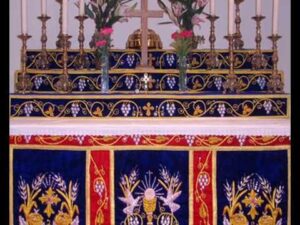The Holy Altar Covering Cloths

Altar Cloth
The Altar cloths are special cloths, used to cover the Holy Altar during worship services and celebrations. They often left on the altar when it is not in use. They consist of a white linen, Chitola, the front draping and the Corporal (Virikoottam)
White Linen
The Holy altar is draped with a white cloth of fine silk or linen, with fringes and covers, the frontal top portion of the Holy Altar completely, with the fringes falling to the front over the chitola. The white linen representing the winding sheet in which the body of our Lord was wrapped (Jn. 20: 7). The white linen is also interpreted as the Church – the triumphant, militant and the suffering Church.
Chitola
The upper colorful, embroidered, cloth covering is called Chitola. It covers the altar to the ground and has three symmetrical sections, denoting Trinity and the three divisions are of the same color signifying the co-equality of the three persons of Holy Trinity. There is a cross in the middle section representing our Lord Jesus Christ. Chitola also represents the seamless garment, of Jesus Christ, woven in one piece from top to bottom (Jn. 19:23). The Chitola symbolizes the universe and is embroidered with wheat and vine stalks.
The upper cloth, covering the steps of the altar is made up of rich, brilliant material and represents the glory of God’s throne. However, during Passion Week, the black colour is used.

THE CORPORAL (VIRIKOOTTAM)
This is a Tri-coloured altar spread measuring over 32″ X 27″ spread at the centre of the Chitola covering the portable altar and extending down on the front side. The frontal of this is usually decorated with ornamental embroidered work. This is made of three pieces of different colours red, green and white. The outer red represents the omnipresence and omnipotence of God the inner green stands for the world and represents the grace of God given through. The innermost white piece stands for the Holy Church, a community of redeemed people. Another interpretation is that three colours stands for the fiery universe, the verdant earth and the Holy Church, symbolising that our Saviour is the Lord of all.
The white piece covers the Tabailaitha. The Paten and Chalice (the Holy Body and Blood) are placed over it. This white portion signifies that our Lord gave His Body and Blood to the Holy Church (made white in the blood of the Lamb; Rev. 7: 14)
0 Comments